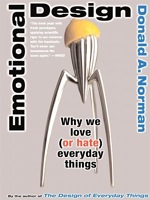 User-experience (UX) storytelling was one of the storytelling applications that was new to me in 2009. I interviewed Whitney Quesenbery (who is writing a book on the subject) and wrote about Cindy Chastain.
User-experience (UX) storytelling was one of the storytelling applications that was new to me in 2009. I interviewed Whitney Quesenbery (who is writing a book on the subject) and wrote about Cindy Chastain.
Now, along comes Francisco Inchauste, who has published a wonderfully written and illustrated blog entry that not only explains the basics of storytelling in UX but also serves as a basic primer for many other storytelling applications. Best of all, Inchauste’s blog entry is just Part 1, so we can look forward to one or more installments.
Although I don’t entirely agree with Inchauste’s assertion that the fragmentation of today’s information flow has diminished the personal touch and opportunity for personal connection, I heartily support his statement: “Using storytelling, however, we can pull these fragments together into a common thread.” He says “user experience professionals and designers are using storytelling to create compelling experiences that build human connections.”
Inchauste begins by noting that all stories follow the same mythic archetypes. Think Star Wars, whose special effects dressed up the Hero’s Journey. He borrows a grid from the Star Wars Origins site that shows common mythic elements in movies such as Star Wars and The Matrix. He asserts, “Great stories, though, don’t just happen randomly; they are designed.”
Donald Norman’s book  Emotional Design is Inchauste’s source for the three levels of How the Brain Processes an Experience — through visceral design, behavioral design, and reflective design — this last seemingly most relevant to storytelling in that “we associate products with our broader life experience and associate meaning and value to them.”
Emotional Design is Inchauste’s source for the three levels of How the Brain Processes an Experience — through visceral design, behavioral design, and reflective design — this last seemingly most relevant to storytelling in that “we associate products with our broader life experience and associate meaning and value to them.”
Having laid that foundation, Inchauste writes: “Knowing that emotion is so vital to how we think makes it more important to create not just a functional and usable experience, but to seek and make a meaningful connection,” which is his lead-in to the basics of storytelling for user experience:
At a basic level, storytelling and user experience have common elements — like planning, research, and content creation — that can be utilized for effectively developing an experience. Storytelling offers a way for the team to really understand what they are building and the audience that they are creating it for. Stories allow for the most complex of ideas to be effectively conveyed to a variety of people. This designed product/experience can then offer meaning and emotion for its users. … With storytelling, a diverse team creating a website or application can collectively link together the tangible elements and create something that is a meaningful experience and is more than just bits and bytes.
A point of controversy, at least for one commenter to the blog entry, is Inchauste’s explanation of how designers should define the users for whom they are designing experiences: “By building a fictional representation of the user that is based on real research and observation, we are able to empathize with them and really understand their needs. Using the created personas and then creating stories about them, we are able to cast a more meaningful vision of the project.” He presents a very detailed profile of such a fictional representation of the user. Reader Josh Walsh demurs on the fictional aspect:
I disagree. Personas should definitely not be fictional in any way. The names may be changed, but the motivations, experiences and disciplines of people should not be averaged into a fictional character. When measure how real people interact with your design, you should keep people as real as possible.
While I know little about user-experience design, Walsh’s view on this point makes more sense to me than does Inchauste’s.
The benefits of deploying storytelling in User-Experience Design, Inchauste says, are that storytelling:
- Puts a human face on dry data
- Can simplify complex ideas for a team
- More efficient team collaboration and purpose
- Insight into the key users
- Setting a project direction faster
- Better communication within large agencies/organizations
- Experience delivers meaning and value to users
Like many of the commenters to the blog post, I’m really looking forward to Part 2.
